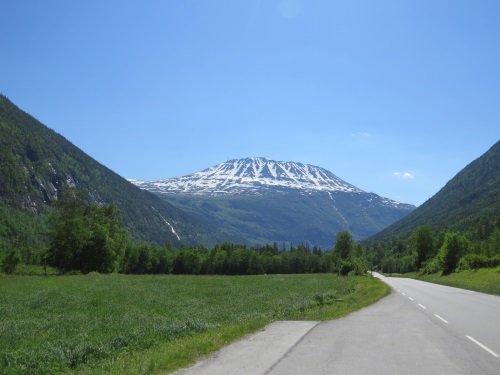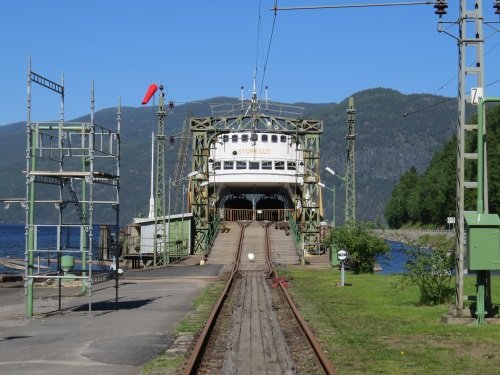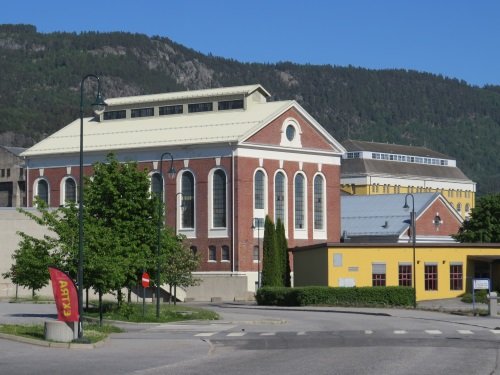Els Slots
WHS #604: Rjukan / Notodden
Rjukan/Notodden Industrial Heritage Site was added to the WH List last year. It’s a niche site that very few will have visited before its designation - our visitor count currently still stands on a modest 17. It’s also one of the clearest examples of under-represented cultural properties brought forward by the Filling the Gaps study of ICOMOS (2005): a ‘developing technology’ related to ‘energy conversion and utilization’. At Rjukan/Notodden, hydro energy was created using the natural power of waterfalls and river.

|
| Gaustatoppen, casting its shadow over Rjukan |
Of course I had done my usual preparations: reading the ICOMOS review and the nomination dossier, plus some additional Googling on certain subjects. But I had difficulty to grasp what this WHS exactly involves. What will follow is a reconstruction that hopefully will provide a starting point for future WH travellers.
First of all, this is a linear WHS. It covers the flow of the water downhill via two rivers and a lake, plus the railway tracks and the land in between that run parallel to the water. The core zone is 93km in length, and stretches between the towns of Rjukan and Notodden. Rjukan lies a little over 3 hours west from Oslo Airport. The E37 road runs parallel to the river and railway. It is an easy and quiet route to drive (there are also buses).
While driving I was constantly on the lookout for 'something industrial' - this is an industrial WHS after all. What you get though is the quintessential Norwegian landscape with dark blue lakes and forested mountains. The weather was glorious too on the first Saturday in June, so it was all very pleasant. But the relevance to a technology site eluded me.

|
| Railway ferry |
My first ‘find’ I did near Tinnsjö Lake, almost half-way. Beneath a shelter at a parking lot I stumbled upon a kind of steam rail car on wheels, a Lokomobil from 1903 . Across the road stands an information panel about the Lake itself: it was the spot of an act of resistance in World War II when a railway ferry laden with "heavy water" (required for hydrogen bombs) was brought down by the Norwegian resistance.
The closer I got to Rjukan, the more dramatic the landscape became. The 1,883m high Gaustatoppen, the highest mountain in the region and still fully-covered in snow, beaconed. The town of Rjukan was built from scratch by hydropower producer Hydro in the early 1900s for its workers. It lies literally in the shadow of this high mountain, from September to March no sunlight reaches the houses. Only in 2013, the residents decided to do something about it: mirrors have been placed on top of the mountain so the sunlight is reflected back into the village.
Hydro had chosen this spot because of the Rjukanfossen: a high and steep waterfall, which produced a lot of power. There is a viewpoint just north of Rjukan from where you can see this. Only there’s no water flowing anymore! The course of the river has been diverted because of a modern hydropower station. The original hydroelectric plant now houses the Vemork Workers Museum. It sits high on the hillside, a 20-minute climb from the car park across a narrow riverbridge where people were bungeejumping (again: no water). The museum itself focuses strongly on the WWII-connotations of the site, and less on the hydroelectric story. There is one main hall with shiny black steam engines and pumps: here it resembles the closest comparable WHS, the Ir. D.F. Woudagemaal .

|
| Notodden |
Just outside Rjukan I made another quick stop: this time at one of the two railway ferries. These old ships have been lovingly restored to their former state. It's funny to see how the railway track runs right down to the lake’s edge, and then connects with the tracks on the ferry. Meanwhile it was getting late already, so I just drove on the Notodden: a messy little town, with even less of industrial history visible at first sight than elsewhere on the route.
So what’s the verdict about this WHS? You’ll have to keep in mind that it is a relict industrial landscape – the same area is also used for modern industries, town life and nature tourism. On paper (such as in the nomination dossier) it is easy to focus on the early 20th century industrial elements, but in reality they hardly stand out. I also believe that the Norwegian cultural or tourism authorities could do more about the interpretation of this WHS to visitors. Except for the Vemork Museum, the remaining elements seem to be kept going by volunteers. There are hardly any signs pointing to wortwhile elements of the industrial landscape. I never found the Tinfos power plants for example, two of the most prominent structures highlighted in the nomination.
More on
Els SlotsComments
No comments yet.
